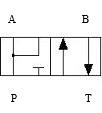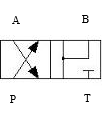4-Way 2-Position Directional Valve (2P)
Libraries:
Simscape /
Fluids /
Two-Phase Fluid /
Valves & Orifices /
Directional Control Valves
Description
The 4-Way 2-Position Directional Valve (2P) models a valve with four openings — such as the valves between an actuator, pump, and tank — in a two-phase fluid network. A single spool controls the valve operation according to the signal at port S. You can set the baseline configuration of your valve by specifying the orifices that are open when the spool moves in the positive direction and negative directions in the Positive spool position open connections and Negative spool position open connections parameters, respectively. You can set the valve opening model in the Orifice parameterization parameter as a linear relationship or function of user-provided data, which you can apply to one or all flow paths in the valve.
This block is a composite component that comprises of multiple instances of the Orifice (2P) block. Refer to the Orifice (2P) block for more details about valve parameterizations and block calculations. In some configurations, this valve resembles a 3-way valve. To set additional flow paths when the spool is in the neutral position, see the 4-Way 3-Position Directional Valve (2P) block.
This image shows an example valve setup where the valve is connected to a tank,
actuator, and pump and the Positive spool position open connections
parameter is P-B, A-T:

This image shows the valve when the Negative spool position open
connections parameter is P-A, B-T:
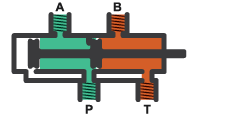
In this configuration, when the signal at port S moves the spool to a negative position, the paths between ports P and A and between ports B and T are open to flow. The paths between ports P and B and ports A and T are closed to flow.
This image shows the valve when the Positive spool position open
connections parameter is P-B, A-T:
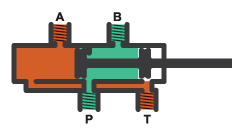
In this configuration, when the signal at port S moves the spool to a positive position, the paths between ports P and B and between ports A and T are open to flow and the paths between ports P and A and between ports B and T are closed.
The schematic that represents this configuration is:
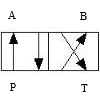
The left-hand side corresponds to the positive position and the right-hand side corresponds to the negative position. The valve transitions through positions in the neutral mid-section.
Spool Displacement and Valve Configuration
The spool stroke is the amount of spool travel an orifice takes to fully open from a closed position. You can use the Orifice parameterization and Area characteristics parameters to specify the flow path characteristics:
| Orifice Parameterization | Identical for All Flow Paths | Different for Each Flow Path |
|---|---|---|
Linear - Area vs. spool
travel | The Spool travel between closed and open orifice parameter defines the spool stroke | The Spool travel between closed and open orifice parameter defines the spool stroke for each orifice |
Tabulated data - Area vs. spool
travel | The difference between the first and last element of the Spool travel vector parameter defines the spool stroke | The difference between the first and last element of the Spool travel vector parameter for each orifice |
Tabulated data - Volumetric flow rate vs. spool
travel and pressure dropor
Tabulated data - Mass flow rate vs. spool
travel and pressure drop | The difference between the first and last element of the Spool travel vector, ds parameter defines the spool stroke | The difference between the first and last element of the Spool travel vector, ds parameter defines the spool stroke for each orifice |
The direction of the spool movement depends on the spool stroke, orifice orientation, and signal at port S. This table shows the spool travel for an orifice depending on the selections for the Positive spool position open connection and Negative spool position open connection parameters:
| Spool Position When Orifice Is Open | Spool Travel, ΔS |
|---|---|
| Orifice always closed: orifice not selected for the Positive spool position open connection or Negative spool position open connection parameters | N/A |
| Orifice always open: orifice selected for both the Positive spool position open connection and Negative spool position open connection parameters | N/A |
| Negative: orifice selected for only Negative spool position open connection parameter | Sorifice_max + spool stroke – S |
| Positive: orifice selected for only Positive spool position open connection parameter | Sorifice_max – spool stroke + S |
Where Sorifice_max is the spool position at the maximum orifice area defined for each orifice. The orifice area saturates at the leakage area when ΔS is negative and saturates at the maximum orifice area when the orifice is fully open. When the orifice is fully open, ΔS is equal to the spool stroke, so ΔS greater than the spool stroke does not further increase the orifice area.
This table shows the possible configurations of the 4-Way 2-Position Directional Valve (TL):
| Configuration | Parameter Values |
|---|---|
All four paths are closed during transition. |
|
All four paths are open during transition. |
|
A-T and B-T are closed during transition. |
|
P-A and P-B are closed during transition. |
|
P-B and B-T are closed during transition. |
|
P-A and A-T are closed during transition. |
|
P-A, P-B, and B-T are open during transition. |
|
P-A, A-T, and B-T are open during transition. |
|
P-A and P-B are closed during transition. A-T is always closed. |
|
All paths are closed during transition. |
|
A-T is open during transition. P-A is closed during transition. |
|
B-T is open during transition. P-B is closed during transition. |
|
P-A is closed during transition. |
|
P-B is closed during transition. |
|
Valve Orifice Parameterizations
The Modeling option parameter controls the parameterization options for a valve designed for modeling either vapor or liquid, but does not impact the fluid properties. The block calculates fluid properties inside the valve from inlet conditions.
The Orifice parameterization parameter specifies the model
for the open area or flow rate through one or all of the valve orifices. If you set
Area characteristics to Identical for all flow
paths, the block applies the same data for all flow paths. When
you select Different for all flow paths, the block uses
individual parameterizations for each flow path.
When Modeling option is Liquid operating
condition, the block parameterizations are designed for a
valve controlling liquid flow.
When Orifice parameterization is Linear -
Area vs. spool travel, the opening area is a linear function
of the spool position received as a signal at port S
where:
ΔS is the spool travel.
Aorifice saturates at Aleak when ΔS is negative and saturates at Amax when the orifice is fully open. When the orifice is fully open, ΔS is equal to the spool stroke, so a value of ΔS that is greater than the spool stroke does not increase the orifice area.
ΔSmax is the value of the Spool travel between closed and open orifice parameter.
Amax is the value of the Maximum orifice area parameter.
Aleak is the value of the Leakage area parameter.

When the valve is in a near-open or near-closed position in the linear parameterization, you can maintain numerical robustness in your simulation by adjusting the Smoothing factor parameter. If the Smoothing factor parameter is nonzero, the block smoothly saturates the opening area between Aleak and Amax. For more information, see Numerical Smoothing.
When Orifice parameterization is Tabulated data - Area
vs. spool travel, you can provide spool travel vectors for
your system or for individual flow paths between ports P,
A, B, and T.
The block uses this data to calculate the relationship between the orifice area
and spool displacement. The block uses interpolation to determine the opening
area between given data points. Aleak
and Amax are the first and last
parameters of the opening area vector, respectively.
When Orifice parameterization is Tabulated
data - Nominal mass flow rate vs. spool travel, the block
calculates the mass flow rate for each orifice from the nominal conditions you
specify in the block parameters. The spool position signal from port
S scales the orifice opening area, which can also scale
mass flow rate.
When Modeling option is Vapor operating
condition, the block parameterizations are designed to model a
valve that controls vapor flow.
The method the block uses to control each orifice depends on the Opening characteristic parameter:
Linear— The measure of flow capacity depends on the spool position at port S. As the spool displaces to open to orifice, the measure of flow capacity scales from the specified minimum to the specified maximum.Tabulated— The block calculates the measure of flow capacity as a function of the spool position at port S. This function uses a one-dimensional lookup table.
The Orifice parameterization parameter determines how the block calculates the flow rate in each orifice:
Cv flow coefficient— The flow coefficient Cv scales the flow rate in each orifice. The flow coefficient measures the ease with which a fluid can flow when driven by a certain pressure differential.Kv flow coefficient— The flow coefficient Kv, where , scales the flow rate in each orifice. The flow coefficient measures the ease with which a fluid can flow when driven by a certain pressure differential.Orifice area— The size of the orifice area scales the flow rate in each orifice.
Visualize Orifice Openings
To visualize the spool offsets and maximum displacement, right-click the block and select Fluids > Plot Valve Characteristics. The plot shows the orifices specified by the parameters in Valve Configuration section. When you set the parameters in the Valve Configuration tab to the same orifice, the orifice opening is a constant.
Click Reload Data to update the data in the figure.
This image shows the default configuration for the block:
Positive spool position open connections is
P-A, B-TNegative spool position open connections is
P-B, A-T
All other spool positions are at the default values.

Assumptions and Limitations
There is no heat exchange between the valve and the environment.
When Modeling option is
Liquid operating condition, the results may not be accurate outside of the subcooled liquid region. When Modeling option isVapor operating condition, the results may not be accurate outside of the superheated vapor region. To model a valve in a liquid-vapor mixture, set Modeling option toLiquid operating condition.
Ports
Conserving
Input
Parameters
Extended Capabilities
Version History
Introduced in R2024b



